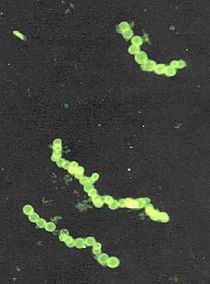Thiotrichales facts for kids
Thiotrichales is a large group of Bacteria. This group includes some very interesting types of bacteria, like Francisella tularensis, which can cause an illness called Tularemia, and Thiomargarita nambiensis, which is known as the biggest bacterium ever found!
Quick facts for kids Thiotrichales |
|
|---|---|
 |
|
| Thiomargarita namibiensis | |
| Scientific classification | |
| Kingdom: | |
| Phylum: | |
| Class: |
Gamma Proteobacteria
|
| Order: |
Thiotrichales
|
| Families | |
|
Thiotrichaceae |
|
Contents
What Are Thiotrichales?
Thiotrichales are a special group, or "order," of Bacteria. Bacteria are tiny living things, so small you need a microscope to see them. They are found almost everywhere on Earth! Some bacteria are helpful, and some can cause sickness.
Giant Bacteria: Thiomargarita
One amazing member of the Thiotrichales group is called Thiomargarita namibiensis. Its name means "sulfur pearl of Namibia." This bacterium is famous because it's the largest bacterium known to science!
How Big Is It?
Most bacteria are super tiny, but Thiomargarita namibiensis can be seen with just your eyes. It looks like a small white bead. It can grow up to 0.75 millimeters wide. That's about the size of a poppy seed or even a fruit fly's eye!
Where Does It Live?
Thiomargarita namibiensis lives in the ocean, especially in areas off the coast of Namibia in Africa. It likes places where there isn't much oxygen. It gets its energy from chemicals like sulfur, which is why it's called a "sulfur pearl."
Tiny Germs: Francisella
Another important bacterium in the Thiotrichales group is Francisella tularensis. This bacterium is very different from the giant Thiomargarita. It is much, much smaller.
What Does It Do?
Francisella tularensis is known for causing an illness called Tularemia. This illness can affect both animals and people. It's important to know about these bacteria so we can understand how to stay healthy.
How Does It Spread?
People can get Tularemia in different ways. Sometimes, it spreads through bites from insects like ticks or flies. It can also spread if someone touches an infected animal. Scientists study these bacteria to learn how to prevent and treat the illness.
See also
 In Spanish: Thiotrichales para niños
In Spanish: Thiotrichales para niños

